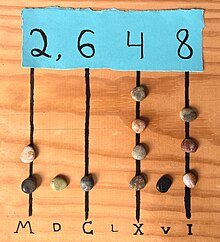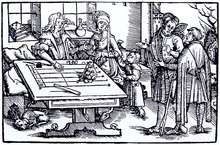56:, and the earliest known form of a counting device (excluding fingers and other very simple methods). Counting boards were made of stone or wood, and the counting was done on the board with beads, pebbles etc. Not many boards survive because of the perishable materials used in their construction, or the impossibility to identify the object as a counting board.The counting board was invented to facilitate and streamline numerical calculations in ancient civilizations. Its inception addressed the need for a practical tool to perform arithmetic operations efficiently. By using counters or tokens on a board with designated sections, people could easily keep track of quantities, trade, and financial transactions. This invention not only enhanced accuracy but also fueled the development of more sophisticated mathematical concepts and systems throughout history.
20:
281:
37:
31:
and spaces between the lines represent 5 times the adjacent power of ten. The pictured number is 2,648, or in Roman numerals, MMDCXXXXVIII. The exact form and use of common ancient counting boards is not known, as few ancient counting boards and no ancient written instructions have survived.
59:
The counting board does not include a zero as we have come to understand it today. It primarily used Roman numerals to calculate. The system was based on a base ten or base twenty system, where the lines represented the bases of ten or twenty, and the spaces representing base fives.
78:
in 1899. It is thought to have been used as more of a gaming board than a calculating device. It is marble, about 150 x 75 x 4.5 cm, and is in the
259:
322:
223:
168:
133:
341:
346:
23:
This simple counting board consists of a wooden board with lines drawn on it, with pebbles (Latin:
315:
249:
96:
Rechenbuch auf Linien und
Ziphren in allerlei Handthierung / geschäfften und Kaufmanschafft
8:
79:
296:
308:
147:
255:
205:
247:
William A. Goddard III, Donald
Brenner, Sergey Edward Lyshevski, Gerald J Iafrate.
113:
292:
75:
64:
19:
335:
209:
28:
227:
288:
193:
108:
41:
90:
280:
83:
53:
36:
86:. It has carved Greek letters and parallel grooves.
251:
40:
Rechentisch/Counting board (engraving probably from
333:
316:
94:
134:History of the Abacus and Ancient Computing
323:
309:
145:
93:described the use of counting boards in
74:) was discovered on the Greek island of
35:
18:
334:
191:
166:
63:The oldest known counting board, the
275:
146:Fernandes, Luis (January 11, 2015).
27:) used as counters. Lines represent
13:
254:. CRC Press. 2002. p. 6-PA3.
14:
358:
194:"Calculations in Medieval Europe"
136:from Kochi Arts and Science Space
279:
167:Poccia, Danilo (June 26, 2023).
241:
216:
185:
160:
139:
126:
1:
148:"The Abacus: A Brief History"
119:
68:
295:. You can help Knowledge by
7:
102:
10:
363:
274:
224:"Ancient Counting Boards"
173:Chronicles of computation
89:The German mathematician
132:Vladimir Esaulov (2019)
52:is the precursor of the
169:"Roman counting boards"
291:-related article is a
95:
45:
33:
16:Early computing device
198:Mathematics in School
192:Oliver, Jack (1997).
39:
22:
80:Epigraphical Museum
342:Mathematical tools
46:
34:
347:Mathematics stubs
304:
303:
261:978-1-4200-4062-3
354:
325:
318:
311:
283:
276:
266:
265:
245:
239:
238:
236:
235:
226:. Archived from
220:
214:
213:
189:
183:
182:
180:
179:
164:
158:
157:
155:
154:
143:
137:
130:
98:
73:
70:
362:
361:
357:
356:
355:
353:
352:
351:
332:
331:
330:
329:
272:
270:
269:
262:
248:
246:
242:
233:
231:
222:
221:
217:
190:
186:
177:
175:
165:
161:
152:
150:
144:
140:
131:
127:
122:
114:Reckoning board
105:
71:
17:
12:
11:
5:
360:
350:
349:
344:
328:
327:
320:
313:
305:
302:
301:
284:
268:
267:
260:
240:
215:
184:
159:
138:
124:
123:
121:
118:
117:
116:
111:
104:
101:
65:Salamis Tablet
50:counting board
15:
9:
6:
4:
3:
2:
359:
348:
345:
343:
340:
339:
337:
326:
321:
319:
314:
312:
307:
306:
300:
298:
294:
290:
285:
282:
278:
277:
273:
263:
257:
253:
252:
244:
230:on 2008-01-03
229:
225:
219:
211:
207:
203:
199:
195:
188:
174:
170:
163:
149:
142:
135:
129:
125:
115:
112:
110:
107:
106:
100:
97:
92:
87:
85:
81:
77:
72: 300 BC
66:
61:
57:
55:
51:
43:
38:
30:
29:powers of ten
26:
21:
297:expanding it
286:
271:
250:
243:
232:. Retrieved
228:the original
218:
204:(3): 12–14.
201:
197:
187:
176:. Retrieved
172:
162:
151:. Retrieved
141:
128:
88:
62:
58:
49:
47:
24:
289:mathematics
336:Categories
234:2008-04-01
178:2024-09-04
153:2024-09-04
120:References
109:Calculator
42:Strasbourg
210:0305-7259
91:Adam Ries
103:See also
76:Salamis
25:calculi
258:
208:
84:Athens
54:abacus
287:This
293:stub
256:ISBN
206:ISSN
48:The
82:in
338::
202:26
200:.
196:.
171:.
99:.
69:c.
324:e
317:t
310:v
299:.
264:.
237:.
212:.
181:.
156:.
67:(
44:)
Text is available under the Creative Commons Attribution-ShareAlike License. Additional terms may apply.

